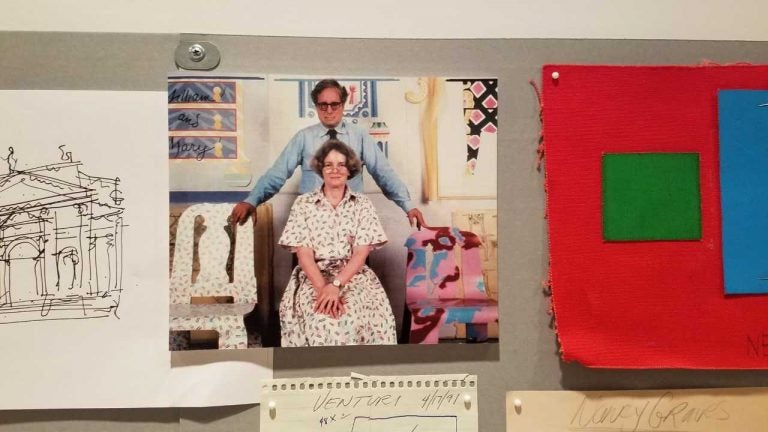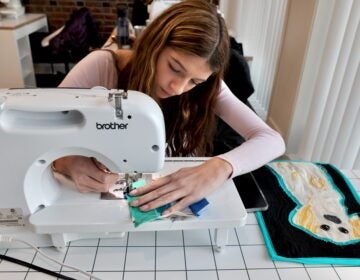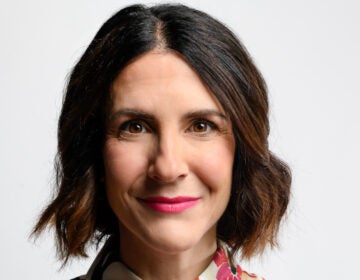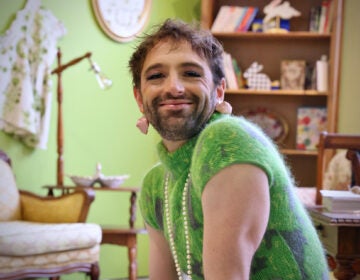Fabric Museum bares all for 40th anniversary
Philadelphia's Fabric Workshop and Museum looks back on 40 years of artist residencies.
Listen 2:06
Architects Robert Venturi and Denise Scott Brown had a residency at Fabric Workshop and Museum in Philadelphia in 1984. (Fabric Workshop and Museum)
To celebrate its 40th anniversary, the Fabric Workshop and Museum in Philadelphia has opened a retrospective exhibit of work created in its Center City location.
Since its beginning, the contemporary art institution has invited artists to create new work. And “Process and Practice” shows the messy way art is made.
Many of the final pieces are impressive — such as a floor-to-ceiling curtain by Jim Hodges, made of thousands of flower cut-outs sewn together or a furnished Victorian drawing room by Renee Green, who upholstered the scene in toile fabric printed with images of a Haitian slave rebellion.
Since 1977, more than 300 artists have been invited to the Fabric Workshop and Museum’s residency program to make something. They include big-name artists Claes Oldenburg, Roy Lichtenstein, Laurie Anderson, and the architects Robert Venturi and Denise Scott Brown. The program also championed rising artists who would become big, such as Jun Kaneko and Kara Walker.
“Not only do we encourage experimentation, but we don’t discourage failure,” said director Susan Talbot. “We want to give the artist the ability to start down one path, and then turn around, come back, and start down a completely different path.”
After their pieces are finished and their residencies end, the artists leave behind scraps from their trial-and-error creative process — swatches of fabric, doodles, cryptic notes-to-self — that are boxed up and stored. Talbot, who discovered 371 boxes in the archive, pulled out dozens to mined them for material. She wanted to exhibit how art is made, warts and all.
She describes digging through the boxes as an act of archaeology. Inside are things the artists were using for inspiration, ideas that went nowhere, and creative tools for making the final piece. To make a pair of astronaut suits in 2002, the British-Nigerian artist Yinka Shonibare wanted to reference the Philadelphia Sound. He scoured used record stores to find LPs by Philly soul bands like the Intruders and O’Jays to lift graphics for the customized fabric. Those vinyl records are still in the box.
Carrie Mae Weems left behind photocopied pages of ads from the Philadelphia Yellow Pages, circa 1993, to find just the right script font for her embroidered screen, “The Apple of Adam’s Eye.” In the bottom of the archival box left behind by Vito Acconci in 1986, Talbot found a manila folder filled with pornography.
“We’re more than just an art museum. We really are a studio and a workshop,” she said. “They can make fabulous finished works, but they also have the freedom to experiment, and even to fail.”
Talbot is relatively new to the Fabric Workshop and Museum. It was founded by Marion “Kippy” Stroud, who directed it for 38 years until her death two in 2015. She ran the organization primarily on her strong passion and significant personal wealth.
“I think it was the will of her passion, the fact that she could afford to fund the organization, and she had such credibility in the art world that artist wanted to come and work here,” said Talbot.
Several former employees of the Fabric Workshop and Museum found working with Stroud to be difficult; after she died, Talbot came in to “professionalize” the organization.
“Kippy was not a manager. She was a visionary, and many visionaries are not managers,” said Talbot. “When I came I realized so many general best practices that museums use were missing here.”
Going forward, the Fabric Workshop and Museum is now on solid financial footing, and attendance has almost tripled in the last two years, according to Talbot. Although the gallery spaces inside its building on Arch Street can be awkward — “Process and Practice” is spread out over the second, third and eighth floors — she has no intention of relocating.
Rather, she intends to run a tight ship, free of debt, and lean on partnerships with art colleges and universities in the area to grow programs focused on local audiences.
WHYY is your source for fact-based, in-depth journalism and information. As a nonprofit organization, we rely on financial support from readers like you. Please give today.





